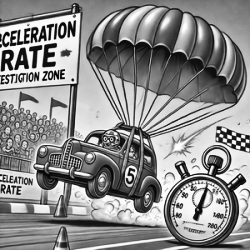Deceleration Rate Calculator

The Deceleration Rate Calculator determines the rate at which an object decelerates based on its initial velocity, final velocity, and the time it takes to decelerate. This tool is ideal for analyzing braking systems, motion control, or studying physics-related problems. You can select velocity units from metres per second (m/s), feet per second (ft/s), kilometres per hour (km/h), or miles per hour (mph) and enter time in seconds. The calculator outputs the deceleration rate in metres per second squared (m/s²) and feet per second squared (ft/s²).
Deceleration Calculator
Calculator
- enter the initial velocity of the object and select the velocity unit you want to use in your calculation
- the final velocity of the object, and the calculation unit
- the time it takes for the object to decelerate, in seconds, minutes, or hours
- decimal precision, the number of digits after the decimal point
Results
- the rate of deceleration in metres per second squared
- the rate of deceleration in feet per second squared
Formula:
The deceleration rate is calculated using the formula:
\[ a = \frac{v_0 - v}{t} \]
Where:
- \(a\): Deceleration rate (m/s² or ft/s²)
- \(v_0\): Initial velocity (m/s, ft/s, km/h, mph)
- \(v\): Final velocity (m/s, ft/s, km/h, mph)
- \(t\): Time (seconds)
Example Calculation:
Scenario: A car decelerates from an initial velocity of \(90 \, \text{km/h}\) to a final velocity of \(36 \, \text{km/h}\) over a time of \(5 \, \text{seconds}\). What is the deceleration rate?
Step 1: Convert velocities to meters per second:
\[ v_0 = 90 \, \text{km/h} \div 3.6 = 25 \, \text{m/s} \] \[ v = 36 \, \text{km/h} \div 3.6 = 10 \, \text{m/s} \]
Step 2: Apply the formula:
\[ a = \frac{v_0 - v}{t} = \frac{25 - 10}{5} = \frac{15}{5} = 3 \, \text{m/s²} \]
Step 3: Convert to feet per second squared:
\[ a = 3 \, \text{m/s²} \times \frac{1 \, \text{ft}}{0.3048 \, \text{m}} = 9.8425 \, \text{ft/s²} \]
Result:
- Deceleration rate in m/s²: \(3.0 \, \text{m/s²}\)
- Deceleration rate in ft/s²: \(9.84 \, \text{ft/s²}\)
This demonstrates how the calculator can be used for physics or practical applications like vehicle braking analysis.